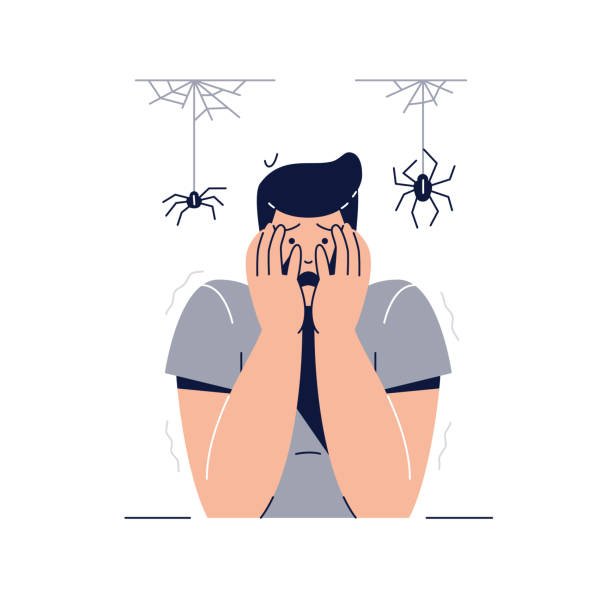Specific phobic Disorder- English

Specific phobic disorders consist of persistent, unreasonable, intense fears (phobias) of specific situations, circumstances, or objects. The fears provoke anxiety and avoidance. The causes of phobias are unknown. Phobic disorders are diagnosed based on history. Treatment is mainly with exposure therapy.
(See also Overview of Anxiety Disorders.)
A specific phobia is a fear of and anxiety about a particular situation or object (see the table Some Common Phobias) to a degree that is out of proportion to the actual danger or risk. The situation or object is usually avoided when possible, but if exposure occurs, anxiety quickly develops. The anxiety may intensify to the level of a panic attack. People with specific phobias typically recognize that their fear is unreasonable and excessive.
Specific phobias are the most common anxiety disorders. Some of the most common are fear of animals (zoophobia), heights (acrophobia), and thunderstorms (astraphobia or brontophobia). Specific phobias affect about 13% of women and 4% of men during any 12-month period. Some cause little inconvenience—as when city dwellers fear snakes (ophidiophobia), unless they are asked to hike in an area where snakes are found. However, other phobias interfere severely with functioning—as when people who must work on an upper floor of a skyscraper fear closed, confined places (claustrophobia), such as elevators. Fear of blood (hemophobia), injections (trypanophobia), needles or other sharp objects (belonephobia), or injury (traumatophobia) occurs to some degree in at least 5% of the population. People with a phobia of blood, needles, or injury, unlike those with other phobias or anxiety disorders, can actually faint because an excessive vasovagal reflex causes bradycardia and orthostatic hypotension.
- Symptoms and Signs of Specific Phobic Disorders
Symptoms depend on the type of phobic disorder.
- Diagnosis of Specific Phobic Disorders
Diagnosis is clinical based on criteria in the Diagnostic and Statistical Manual of Mental Disorders, Fifth Edition (DSM-5).
Patients have
- Marked, persistent (≥ 6 months) fear of or anxiety about a specific situation or object.
In addition, patients have all of the following:
- The situation or object nearly always triggers immediate fear or anxiety.
- Patients actively avoid the situation or object.
- The fear or anxiety is out of proportion to the actual danger (taking into account sociocultural norms).
- The fear, anxiety, and/or avoidance cause significant distress or significantly impair social or occupational functioning.
Also, the fear and anxiety cannot be more correctly characterized as a different mental disorder (eg, agoraphobia, social anxiety, a stress disorder).
|
Phobia |
Definition |
|
Acrophobia |
Fear of heights |
|
Amathophobia |
Fear of dust |
|
Astraphobia |
Fear of thunder and lightning |
|
Aviophobia |
Fear of flying |
|
Belonephobia |
Fear of needles, pins, or other sharp objects |
|
Brontophobia |
Fear of thunder |
|
Claustrophobia |
Fear of confined spaces |
|
Erotophobia |
Fear of female genitals |
|
Gephyrophobia |
Fear of crossing bridges |
|
Hydrophobia |
Fear of water |
|
Odontiatophobia |
Fear of dentists |
|
Phartophobia |
Fear of passing gas in a public place |
|
Phasmophobia |
Fear of ghosts |
|
Phobophobia |
Fear of having fears or developing a phobia |
|
Triskaidekaphobia |
Fear of all things associated with the number 13 |
|
Trypanophobia |
Fear of injections |
|
Zoophobia |
Fear of animals (usually spiders, snakes, or mice) |
- Treatment of Specific Phobic Disorders
The prognosis for untreated specific phobias varies because certain uncommon situations or objects (eg, snakes, caves) are easy to avoid, whereas other situations or objects (eg, bridges, thunderstorms) are common and difficult to avoid.
- Exposure therapy
Because many phobic disorders involve avoidance, the psychotherapy of choice tends to include exposure therapy. With structure and support from a clinician who prescribes exposure homework, patients seek out, confront, and remain in contact with what they fear and avoid until their anxiety is gradually relieved through a process called habituation. Because most patients know their fears are excessive, embarrassing, and disabling, they are usually willing to participate in this therapy—ie, to avoid avoiding.
Typically, clinicians begin with a moderate exposure (eg, patients are asked to approach the feared object, but at a safe distance). If patients describe acceleration of their heart rate or shortness of breath when they encounter the feared situation or object, they may be taught to respond with slow, controlled breathing or other methods that promote relaxation. Or they may be asked to note when their heart rate accelerated and shortness of breath began and when these responses returned toward normal. When patients feel comfortable at one level of exposure, the exposure level is increased (eg, to touching the feared object). Clinicians continue to increase the exposure level until patients can tolerate normal interaction with the situation or object (eg, ride in an elevator, cross a bridge). Exposure can increase as rapidly as patients tolerate it; sometimes only a few sessions are needed.
Exposure therapy helps > 90% of patients who carry it out faithfully and is almost always the only treatment needed for specific phobias.
- Drugs
Short-term therapy with a benzodiazepine (eg, lorazepam 0.5 to 1.0 mg orally) or a beta-blocker (propranolol is generally preferred—10 to 40 mg orally), ideally about 1 to 2 hours before the exposure, is occasionally useful when exposure to an object or situation cannot be avoided (eg, when a person who has a phobia of flying must fly on short notice) or when exposure therapy is either unwanted or has not been successful.
